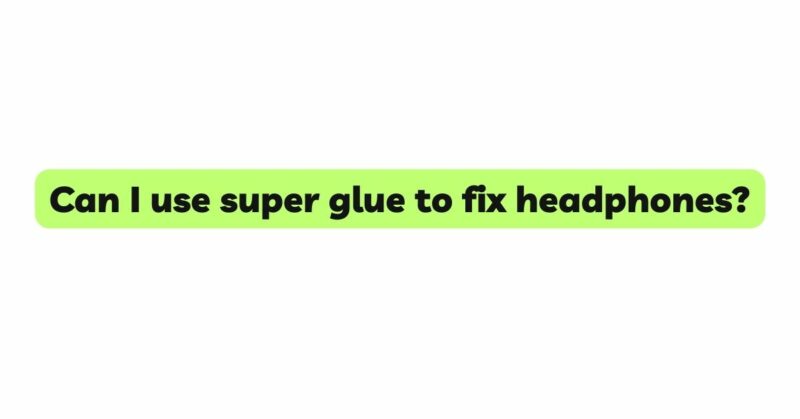Headphones have evolved into an indispensable accessory for millions of individuals worldwide, offering a personalized gateway to an immersive world of music, podcasts, and audio content. However, despite their robust construction, accidents can happen, leading to broken components and compromised audio quality. The allure of a quick fix often prompts headphone owners to consider using super glue to repair their beloved audio companions. Super glue, also known as cyanoacrylate adhesive, is a popular and accessible adhesive used for various DIY projects. But the question remains, can you use super glue to fix headphones effectively and restore them to their former glory? In this article, we will explore the feasibility of using super glue for headphone repairs, the potential benefits and drawbacks of this method, and the crucial precautions to take during the process. From determining the type of damage to seeking professional assistance, we will guide you through the world of headphone restoration with super glue.
- Understanding Headphone Damage:
Headphone damage can manifest in various ways, such as:
- Physical Damage: This includes visible cracks, fractures, or deformities on the external parts of the headphones, such as ear cups, headbands, or connectors. Physical damage can result from accidental drops, impacts, or rough handling.
- Driver Issues: The drivers are the core components responsible for producing sound in headphones. Driver issues may include misalignment, diaphragm deformation, or voice coil problems, leading to distorted or non-functional sound.
- Cable and Connector Problems: Headphone cables and connectors are vulnerable to fraying, bending, or disconnection, resulting in audio disruptions or a complete loss of sound.
- Pros and Cons of Using Super Glue:
Using super glue for headphone repairs has both advantages and disadvantages, which are important to consider:
Pros:
- Quick Bonding: Super glue forms strong bonds rapidly, allowing for immediate repairs and quick fixes.
- Accessibility: Super glue is widely available in stores, making it a readily accessible adhesive option for DIY repairs.
- Versatility: It can bond various materials, making it suitable for fixing different headphone components.
Cons:
- Lack of Flexibility: Once dried, super glue becomes rigid and lacks flexibility, which can be problematic for headphone components that require some degree of movement or flexibility.
- Potential Mess: Super glue can create a mess if not applied carefully, and excess glue may damage headphone surfaces or affect audio quality.
- Toxicity: Super glue emits fumes during the curing process, which can be harmful if inhaled. Adequate ventilation is necessary when using super glue.
- Headphone Components Suitable for Super Glue Repairs:
While super glue can be effective for certain headphone repairs, it is best suited for fixing specific components, including:
- Headband: Small cracks or fractures on the headband can often be temporarily repaired with super glue.
- Ear Pads: If the ear pads have separated from the headphone frame, a small amount of super glue can be used to reattach them.
- Detachable Cables: Super glue can help secure the connection between detachable cables and headphone connectors.
- Precautions When Using Super Glue for Headphone Repairs:
Before attempting any headphone repairs with super glue, it is essential to take precautions to ensure a successful outcome:
- Clean the Surface: Ensure that the surfaces to be bonded are clean, dry, and free of any dirt or debris. This will facilitate better adhesion.
- Apply a Small Amount: Use a minimal amount of super glue to avoid excess spillage and prevent damage to other headphone components.
- Hold in Place: Hold the repaired components firmly in place for a few minutes to allow the glue to bond properly.
- Ventilation: Work in a well-ventilated area when using super glue to avoid inhaling fumes.
- Limitations of Super Glue for Headphone Repairs:
While super glue can be useful for certain types of headphone damage, it has limitations for other issues:
- Lack of Flexibility: Super glue is not suitable for components that require flexibility, such as the ear cups in over-ear headphones.
- Delicate Parts: Delicate components, such as headphone drivers and diaphragms, should not be repaired with super glue, as it may cause irreversible damage.
- Long-Term Durability: Super glue may not provide a long-lasting solution for headphone repairs, especially for components that are subjected to frequent movements or stress.
- Seeking Professional Repairs:
For more complex or irreparable headphone damage, seeking professional repairs is often the best course of action:
- Manufacturer or Authorized Service Center: Contact the manufacturer or an authorized service center to inquire about repair options. They have the expertise and access to genuine replacement parts, ensuring proper restoration of your headphones.
- Cost Considerations: Before proceeding with professional repairs, consider the cost compared to the value of the headphones. In some cases, it may be more cost-effective to invest in a new pair, especially if the headphones are outdated or low-cost models.
- Upgrading to New Headphones:
If the damage to your headphones is extensive or the repair efforts prove unsuccessful, consider upgrading to a new pair that suits your audio preferences and budget.
Conclusion:
Using super glue for headphone repairs can be a viable solution for certain minor issues, offering quick bonding and accessibility for components like headbands, ear pads, and detachable cables. However, it is essential to be cautious when using super glue and consider its limitations, especially concerning flexibility and delicate components like headphone drivers.
For more complex or irreparable damage, seeking professional repairs from the manufacturer or authorized service center is recommended. Additionally, upgrading to a new pair of headphones may be a more suitable option, especially if your current headphones are outdated or low-cost models.
By taking the necessary precautions and being mindful of the limitations, you can make informed decisions when attempting super glue repairs and potentially extend the lifespan of your cherished audio companions.


